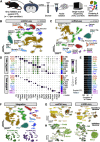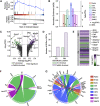Single-Nucleus Profiling Identifies Accelerated Oligodendrocyte Precursor Cell Senescence in a Mouse Model of Down Syndrome
- PMID: 37491366
- PMCID: PMC10449487
- DOI: 10.1523/ENEURO.0147-23.2023
Single-Nucleus Profiling Identifies Accelerated Oligodendrocyte Precursor Cell Senescence in a Mouse Model of Down Syndrome
Abstract
Down syndrome (DS), the most common genetic cause of intellectual disability, is associated with lifelong cognitive deficits. However, the mechanisms by which triplication of chromosome 21 genes drive neuroinflammation and cognitive dysfunction are poorly understood. Here, using the Ts65Dn mouse model of DS, we performed an integrated single-nucleus ATAC and RNA-sequencing (snATAC-seq and snRNA-seq) analysis of the adult cortex. We identified cell type-specific transcriptional and chromatin-associated changes in the Ts65Dn cortex, including regulators of neuroinflammation, transcription and translation, myelination, and mitochondrial function. We discovered enrichment of a senescence-associated transcriptional signature in Ts65Dn oligodendrocyte (OL) precursor cells (OPCs) and epigenetic changes consistent with a loss of heterochromatin. We found that senescence is restricted to a subset of OPCs concentrated in deep cortical layers. Treatment of Ts65Dn mice with a senescence-reducing flavonoid rescued cortical OPC proliferation, restored microglial homeostasis, and improved contextual fear memory. Together, these findings suggest that cortical OPC senescence may be an important driver of neuropathology in DS.
Keywords: Down syndrome; Trisomy 21; oligodendrocyte precursor cells; senescence; single-cell genomics.
Copyright © 2023 Rusu et al.
Conflict of interest statement
The authors declare no competing financial interests.
Figures










Similar articles
-
Cholinergic Senescence in the Ts65Dn Mouse Model for Down Syndrome.Neurochem Res. 2022 Oct;47(10):3076-3092. doi: 10.1007/s11064-022-03659-0. Epub 2022 Jun 29. Neurochem Res. 2022. PMID: 35767135 Free PMC article.
-
Neuroanatomical alterations and synaptic plasticity impairment in the perirhinal cortex of the Ts65Dn mouse model of Down syndrome.Neurobiol Dis. 2017 Oct;106:89-100. doi: 10.1016/j.nbd.2017.06.017. Epub 2017 Jun 23. Neurobiol Dis. 2017. PMID: 28651891
-
Normalizing the gene dosage of Dyrk1A in a mouse model of Down syndrome rescues several Alzheimer's disease phenotypes.Neurobiol Dis. 2017 Oct;106:76-88. doi: 10.1016/j.nbd.2017.06.010. Epub 2017 Jun 21. Neurobiol Dis. 2017. PMID: 28647555
-
Developmental instability of the cerebellum and its relevance to Down syndrome.J Neural Transm Suppl. 2001;(61):11-34. doi: 10.1007/978-3-7091-6262-0_2. J Neural Transm Suppl. 2001. PMID: 11771737 Review.
-
Molecular neuropathology of transgenic mouse models of Down syndrome.J Neural Transm Suppl. 2001;(61):289-301. doi: 10.1007/978-3-7091-6262-0_24. J Neural Transm Suppl. 2001. PMID: 11771752 Review.
References
Publication types
MeSH terms
LinkOut - more resources
Full Text Sources
Medical
Molecular Biology Databases
